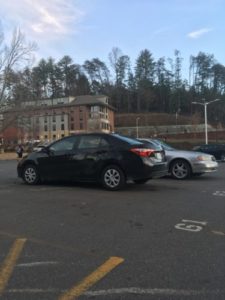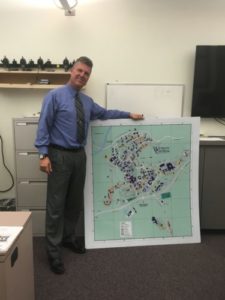This story was co-written with Chris Lang.
With a growing student body and a limited amount of space, students and faculty alike fear for the future of parking on the Western Carolina University campus.
Many students complain about the availability of parking on campus as it is, sometimes claiming that they are unable to find any parking spaces at all.

Coulter Lot is one of the meter lots whose change has been most controversial. Photo by Yustin Riopko.
“It’s not that there isn’t a spot,” explained residential case manager Brian Boyer. “It’s just that you don’t always like where it is.”
Boyer elaborates that one of the biggest negative responses to recent WCU Parking and Transportation decisions is that even when there is parking, it is often so far away from a destination that it seems frustrating and unreasonable.
“Parking on main campus is pretty difficult,” said senior Kali Garrido. “Last year and the year before that wasn’t too bad because commuters had the advantage of parking closer. Now with the new freshman parking we have to park a ways away.”
Some students who had no problem with parking before this year think that WCU Parking and Transportation has made a mistake by re-purposing some lots that used to be designated for commuters as meter lots.
“I think they should move it back to the way it was last year,” said junior Kayla Waller. “I think it worked out fine and they shouldn’t have freshman parking by the Travel Center.”
Fred Bauknecht, director of parking and transportation at WCU, rationalized the most recent changes on lots, addressing the big picture.

Fred Bauknecht, director of parking and transportation at WCU, poses with marked up parking map. Photo by Yustin Riopko.
“I’ll tell you why we did meter lots,” he said. “Everyone needs to be in the center of campus… This is where everyone wants to go. Lot 33 [Coulter lot] used to be a faculty/staff lot. Faculty/staff would come in at 7:00 to 8:00 in the morning and there would be no movement till 5:00.”
Bauknecht explained that metered parking in the center of campus eliminates stagnation, encouraging more movement in and out of the lot, and freeing up space more often where people want it most.
“Since we made it a meter lot, in the 88 spaces, we get anywhere from 150 to 250 people using that lot per day – and anyone can use it!” Bauknecht added.
That’s what Parking and Transportation – and all of the WCU faculty and students who drive – have been dealing with lately. With these concerns at the forefront, people at the university are wondering how rising admissions will impact the parking situation.
According to director of Student Recruitment and Transactions Phil Cauley, the total student population of WCU has grown about 8 percent since 2012, and is expected to continue growing. Most of these students attend classes at the main campus in Cullowhee.
When the NC Promise Tuition Plan takes effect in 2018 and the North Carolina University System begins subsidizing tuition at WCU, admissions are expected to rise even more.
Cauley reassures those worried about the increase that the school is prepared for the changes.
“While we plan for controlled growth, we do so with an understanding of challenges pertaining to our on-campus capacity.”
The administration remains confident in its ability to serve students, even in the wake of the growing population in Cullowhee.
“As we grow, we’ll need equal parking,” acknowledged Bauknecht. “We’re one step ahead.”
The director of parking pointed out that the new residence building, Noble Hall, introduced new living space for 400 students, while the new parking lot by the Health and Human Sciences building created parking space for 500 students – a net gain for room to park.
“Now that everything’s where it’s supposed to be, the only thing we’ll be doing form now on is probably adding lots,” said Bauknecht, who also reassured students that the biggest changes were behind us now.
The director described the vision for the future of parking at WCU and of the campus in general, specifically stating that the goal was to have a walking campus where parking is situated primarily around the perimeter of the university.
In the direction we’re headed, the campus will be greener, better lighted and more efficiently shuttled. Students, faculty, and visitors will leave their cars at the edge of campus and get around either by Cat Tran or by foot.
Bauknecht even predicted that some lots in the center of campus, like the Coulter lot, may be gone and replaced by green space and expanded academic buildings in as soon as five to 10 years.
The administration’s goals for campus will face various degrees of acceptance and scrutiny from those who work and study here, and parking will likely remain a heated issue.
Below is a video summarizing Fred Bauknecht’s motive for making pay lots at the center of campus and some student opinions about the changes.


